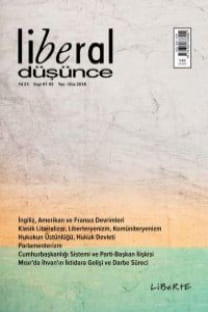Alman Anayasa Hukuku Sisteminde Dini Cemaatlerle Yapılan Din-Devlet Sözleşmeleri : Religionsverfassungsrechtliche Staatsvertraege
Almanya, İnsan Hakları, Devlet Sözleşmeleri, Din Özgürlüğü, Anayasa Hukuku, Kolektif Din Özgürlüğü
Religion – State Contracts with the Religious Communities in the German Constitutional System: Religionsverfassungsrechtliche Staatsvertraege
Freedom of Religion, Constitution, Germany, Religion-State Contracts, Religious Community,
___
- CZERMAK, Gerhard,(2000) “Rechtsnatur und Legitimation der Verträge zwischen Staat und Religionsgemeinschaften”, Der Staat, Vol. 39, No. 1, ss.69-85.
- De WALL, Heinrich, (2004), Die Zukunft des İslam in der staatlichen Ordnung der Bundesrepublik Deutschland und Nordrhein-Westfalens, Rechtliche Voraussetzungen von Verträgen des Staates mit muslimischen Verbänden, Rechtsgutachten, NRW.
- Dilbirliği, Muhterem, (2020), Avrupa’da Din ve Vicdan Özgürlüğü, Adalet Yayınevi, Ankara.
- DOĞAN, Nejat, (2011), “Almanya’nın Avrupa’daki Konumuna Teorik Yaklaşımlar: Almanya’nın Yeniden Birleşmesinden 20 Yıl Sonra Bir Değerlendirme”, Çankırı Karatekin Üniversitesi İktisadi ve İdari Bilimler Fakültesi Dergisi, Cilt: 1, Sayı: 1, Güz, ss. 1 – 19.
- EYECİ, Fahri, (2016), “Aşağı Saksonya Seçimleri ve Devlet Anlaşması”, https://perspektif.eu/2017/10/16/asagi-saksonya-devlet-anlasmasi/ (Erişim 06.04.2021).
- Hans M. HEİNİG,(2003) Öffentlich-rechtliche Religionsgesellschaften, Berlin.
- HOLLERBACH, Alexander,(1989), “§138 Grundlagen des Staatskirchenrechts“, içinde: Josef Isensee (Hrsg.) Handbuch desStaatsrechts der Bundesrepublik Deutschland, Cilt 6, Heidelberg, ss.470-555.
- KELLER Claudia, (2013) “Staatsvertrag mir İslamverbaenden, Der Wert des Symbolischen”, http://www.tagesspiegel.de/politik/staatsvertrag-mitİslamverbaenden-der-w ert-des-symbolischen/7005470.html (Erişim: 02.05.2017).
- KLİNKHAMMER, Gritt / De WALL, Heinrich, (2012), Staatsvertrag mit Muslimen in Hamburg: Die rechts-und religionswissenschaftlichen Gutachten, Bremen.
- MURATOĞLU, Tahir, (2014), “Almanya Federal Cumhuriyeti’nde Devlet Yapılanması”, Gazi Üniversitesi Hukuk Fakültesi Dergisi C. XVIII, ss.291 – 366.
- MÜCKL, Stefan, (2009), “§ 159 Grundlagen des Staatskirchenrechts”, içinde: Isensee/Kirchhof, Handbuch des Staatsrechts, Cilt VII, 3. Auflage, ss.711-788.
- SPEER, Sven, (2016) “Aşağı Saksonya’da “İslam Anlaşması”, Tüm Bu Velvele Boşuna mı?”, Perspektif, S.255, Yıl: Kasım 2016, ss.32-35
- UNRUH, Peter,(2012), Religionsverfassungsrecht, Nomos Verlag, 2. Auflage.
- WILLOWEIT, Dietmar,(2008) “Die Wurzeln des modernen Staates: Deutsche Verfassungsgeschichte vor 1848 – Fünfzehn Merksätze”, http://www.bpb.de/geschichte/deutsche-geschichte/grundgesetz-undparlamentarischer-rat/39181/verfassungsgeschichte-vor-1848 (Erişim: 20.04.2021).
- WOLLSTEIN, Günter, (2008) “Von der Paulskirche bis zur Verfassung von 1871” http://www.bpb.de/geschichte/deutsche-geschichte/grundgesetz-undparlamentarischer-rat/39184/1848-1871 (Erişim 23.04.2021).
- TAŞĞIN, Ahmet, ÖZİPEK, Bekir Berat ve diğerleri, (2016), Avrupa’da Yaşayan Türkiye Kökenli Gençler: Alevilik/Sünnilik temelinde Kimlik, Aidiyet, Sosyal Hayat, Siyaset, İstanbul.
- SPULER-STEGEMANN, Ursula, (2003), Ist die Alevitische Gemeinde Deutschland e.V. eine Religionsgemeinschaft?, Religionswissenschaftliches Gutachten, Marburg.
- SÖKEFELD, Martin, „Sind Aleviten Muslime?, Aspekte einer Debatte unter Aleviten in Deutschland“, Etnoscripts, Cilt:7, S.2 Yıl:2005,
- ISSN: 1300-8781
- Başlangıç: 1996
- Yayıncı: Liberte Yayınları
Organizasyonel Sessizlik, Düşüş ve Ölüm
Bir Türk Siyaseti Okuma Biçimi Olarak Gelenekçi Yaklaşım
Fikri Mülkiyetin Ürün İnovasyonu ve Pazar Şekillenmesi Üzerindeki Yıkıcı Etkileri
Kamusal Alanı Dijitalleşme Çerçevesinde Yeniden Okumak
Kırsalda Katılım Bankacılığı Algısı: Oltu Örneği
Barış Çalışmalarında Sosyal Temsiller Kuramı: Gruplararası Farklılıklar ve Bağlamsal Etkiler
Farabi’den İbn Haldun’a: Erken Dönem Müslüman Entelektüellerin Yazılarında Devlet Algısı
